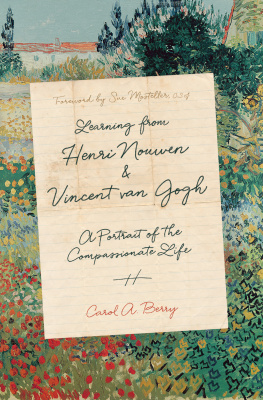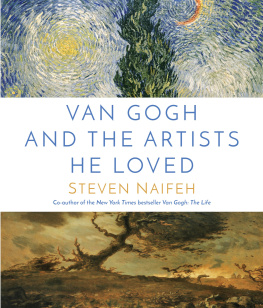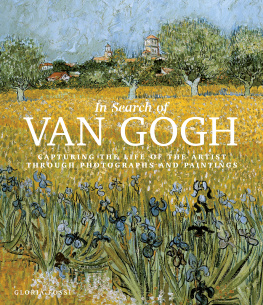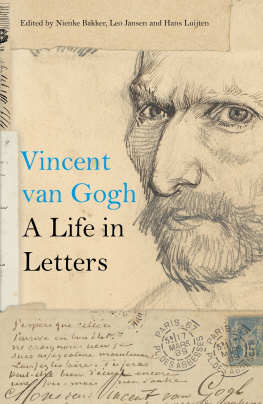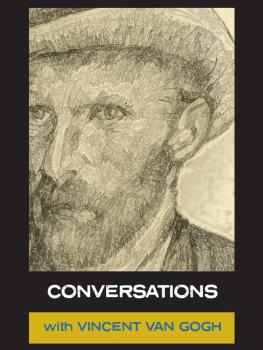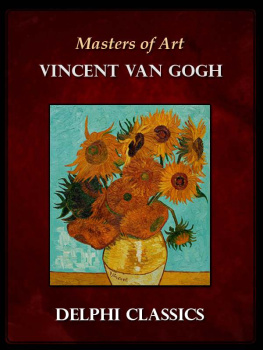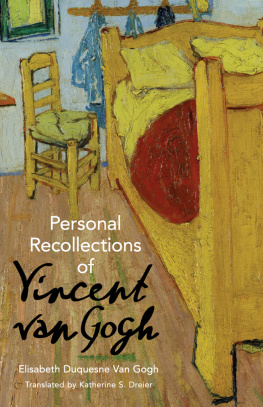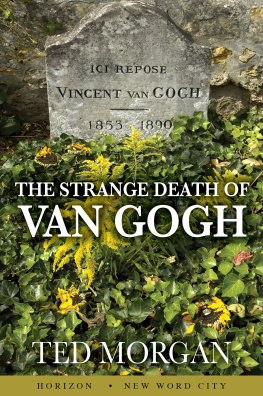

Leaving Van Gogh is a work of historical fiction. Apart from the well-known actual people, events, and locales that figure in the narrative, all names, characters, places, and incidents are the products of the authors imagination or are used fictitiously. Any resemblance to current events or locales, or to living persons, is entirely coincidental.
Copyright 2011 by Carol Wallace
All rights reserved.
Published in the United States by Spiegel & Grau, an imprint of The Random House Publishing Group, a division of Random House, Inc., New York.
SPIEGEL & GRAU and Design is a registered trademark of Random House, Inc.
Library of Congress Cataloging-in-Publication Data
Wallace, Carol
Leaving Van Gogh: a novel/Carol Wallace.
p. cm.
eISBN: 978-1-58836-943-7
1. Gachet, Paul-Ferdinand, 18281909Fiction. 2. Gogh, Vincent van, 18531890
Last yearsFiction. 3. Gogh, Vincent van, 18531890Mental healthFiction.
4. Gogh, Vincent van, 18531890Relations with physiciansFiction.
5. Psychological fiction. I. Title.
PS3573.A42563L43 2011
813.54dc22 2010015082
www.spiegelandgrau.com
Jacket design: Greg Mollica
Hand-lettering: Nancy Harris Rouemy/Go for it Design
Jacket art: Vincent van Gogh, Branch of an Almond Tree in Blossom, 1890 (Van Gogh Museum, Amsterdam/Art Resource, N.Y.); Vincent van Gogh, self-portraits, 1887 (Van Gogh Museum, Amsterdam)
v3.1
For Rick, as always
It is my constant hope that I am not working for myself alone .
V INCENT VAN G OGH TO T HEO VAN G OGH , M ARCH 1888
Contents
P rologue
1905

I HELD V INCENTS SKULL in my hands yesterday. It was a strange and melancholy moment. As I examined the yellowed cranium, my imagination clothed it with flesh; I could see the strong ridge over his eyebrows and the steep ledges of his cheekbones, which were the foundations of his face.
The doctor in me could not help looking for something else as well. Phrenology is out of fashion now, but I am an old man. When I began my medical training, there were doctors who believed the shape of a skull betrayed or predicted a mans mental state. What should this skull have told me then? Should I have detected from it that Vincent was mad? Or that he was a genius? Perhaps that he was both?
I had been hoping Well, it was foolish. I suppose I had been hoping that Vincent would speak to me again. Nonsense, of course. I did not really imagine that a voice would issue from between his few, ruined teeth, but I thought the sight of his skull might prompt a new memory, something I had forgottena phrase, a glance, a gesture that would provide me with new insight into his mental predicament.
Of course I could not wait as long as I would have liked for some ghostly trace. We were reinterring the man. It was no time for investigation.
The ceremony was moving but peculiar. At nearly eighty, I often feel that I have done everything in life, but until yesterday I had never re-buried anyone. We would not have had to disturb Vincents grave if there had been an empty plot alongside it for Theos remains. Now, in a new plot, the modest headstones rise side by side, each engraved plainly with one of the brothers names. Theos body still lies in Utrecht, but his widow promises to bring it to Auvers when she can, because she feels their fraternal bond should be honored, even in death. Not many widowscertainly not those who had remarried, as Madame van Gogh Grosschalk didare so self-effacing. I am certain, though, that she is right.
The new grave site is better. It lies on the north side of the cemetery, against the wall. Vincent would have liked this spot, surrounded as it is by the wheat fields he painted with such bravura and devotion. I transplanted some sunflowers from his first grave; they gave poor Theo pleasure and consolation back then. I am glad to think that something I did might have been a source of comfort to that poor man.
We all waited until the gravedigger had shoveled the last handful of earth onto the coffin. It was a warm afternoon; not as hot as that searing July day fifteen years ago when we last buried Vincent, but hot enough for the gravediggers task to seem interminable. Yet we stood there, Van Goghs survivors if you like, watching the casket vanish beneath the crumbly soil and thinking about him. He told his brother that I was sicker than he, yet there he is, a pile of bones, and here I am, still trying to grasp what he was to me and I to him.
I have known many artists. Vincent was something different. Everyone who knew him well understood this, so I have not been surprised at Theos wifes unremitting efforts to foster his reputation. Of course she does so because she possesses most of his paintings. That is natural. But she must also feel, as I do, that her life was briefly illuminated by the presence of a remarkable person. I have children, but I will have no grandchildren. Marguerite is most emphatically an old maid, and Paul is no family man. If anyone knows my name a hundred years from now, it will be in connection with Vincent van Gogh. His portrait may make me immortal. If it does, I will also be known as the doctor who let him die. Vincent wrote once in a letter that a man who commits suicide turns his friends into murderers. What does that make me?
Many rumors have grown up about his death. So much could not be explained: where the gun had come from, where the gun vanished to, why he shot himself so clumsily. It has been said that the gun was for shooting crows, and that Vincent had borrowed it from Ravoux. It was a rifle, some said, or it was a shotgun, and he tripped over it while trying to shoot rabbits. There is even a talerather more durable than the rabbit nonsensethat Vincent was murdered. He was killed, it is said, by the farmer whose wife he had painted. Some say they had been caught together beneath a haystack. The Parisian version (for some of these stories had even reached as far as the city) mentions an unnamed painter whom Vincent had insulted in a brothel. I dont imagine anyone believed that for very long.
I never respond to the gossip, of course. Why should I tell what I know? It was a secret I shared with Vincent alone. And he took it to the grave.
O ne

W HEN T HEO VAN G OGH first approached me about caring for his brother, I was in my sixties and I had been practicing medicine for thirty-one years. I was well established. My patients were a varied group, but for years I had specialized in diseases of the nerves and mental maladies. A handful of other men in Paris had similar qualifications, but it was my connection to the art world that brought Theo van Gogh to me in the spring of 1890. In fact, it was Camille Pissarro who sent him.
As a boy in Lille, I had studied painting, and through those lessons I came to know Amand Gautier. He was a little younger than I and significantly more talented, so it was no surprise to me that he was accepted to the cole des Beaux-Arts in Paris. I had already spent two years at the Facult de Mdecine when he arrived in Paris in 1852, and my life was much livelier from that day. Gautier was an open, affable man, handsome and eager to make friends. Whats more, his fellow painting students were far more entertaining than my fellow medical students. I cared deeply about medical problems, but what I wanted to talk about was art, so I often went with Gautier to the artists cafs. And thus over the years I came to know them allCourbet and Manet, Pissarro and Czanne, Monet and Renoir, Sisley and Guillaumin.
Next page


